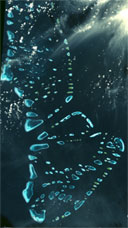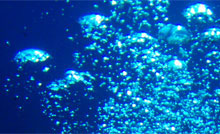Ocean Acidification Series
Ocean Acidification: The Unknown Reality of Climate Change
Plankton Life Already Weakened by CO2
The Luck of the Fish: for How Long?
Finding a Cure Despite Uncertainties
The Hopes of Ecosystem Modelling |
Ocean Acidification: The Unknown Reality of Climate Change |
 Malosmadulu atolls, Maldives- credit: NASA Visible Earth Malosmadulu atolls, Maldives- credit: NASA Visible Earth
|
By Laurene Mainguy, May 2009 |
Global warming is a widely accepted reality. The rise in temperatures has caused dramatic floods and droughts worldwide, and the sea threatens to submerge certain areas of the globe like the Maldives by the end of the century.
This results from releasing too much greenhouse gases in the atmosphere. The world burns a lot of fossil fuels- coal, oil and gas- that release carbon dioxide in the air. The CO2 traps the sun heat in the atmosphere: the heat can't get out and warms our planet.
|
Yet, global warming is not as certain as another major CO2 effect: ocean acidification. ''Because ocean acidification is relatively a chemical reaction between CO2 and water, the accuracy of future predictions for ocean acidification is likely to be more accurate than for global warming,'' said Atsushi Ishimatsu, a fish scientist at Nagasaki University.
Once emitted, CO2 particles do not simply hang in the air. About one third of anthropogenic CO2 emissions get absorbed by the ocean. As the CO2 dissolves in the sea and produces a carbonic acid- H2CO3, the seawater becomes more acidic and changes chemical properties. And those changes are suspected to endanger the whole marine ecosystem.
It is no new phenomenon that the ocean absorbs large quantities of CO2. Like the rainforest, the ocean is a great natural carbon sink. But carbon emissions have already increased from 280 parts per million in 1750 to 380 ppm today. If the trend continues, scientists fear the ocean may no longer be able to digest all that carbon dioxide.
Carbon is to marine organisms what cholesterol is to the human body. We need cholesterol to generate healthy cells, but excess cholesterol in the bloodstream may cause a heart attack. In the ocean, marine organisms need carbon to develop, but excess carbon seems to affect their ability to grow, reproduce and survive.
|
Small changes due to acidification are already noticeable. According to a recent article in Nature Geoscience, researchers at the Antarctic Climate and Ecosystems Cooperative Research Centre in Australia found that the shells of foraminifera plankton are 30% lighter compared to pre-industrial times.
|
 Monemvassãa, Greece- credit: Valerio Barralis Monemvassãa, Greece- credit: Valerio Barralis |
More significant changes are likely to happen, the question being when and under what CO2 conditions. Many scientists expect CO2 emissions to rise up to 560 ppm by 2050. But those who signed the Monaco Declaration about ocean acidification last October recommend to strive for a more ambitious goal: 450ppm.
Long Cao studies the impact of ocean acidification on coral reefs at the Carnegie Institution. ''If we reach CO2 levels double to pre-industrial concentrations, basically coral reefs will start to dissolve,'' he said.
That's because high CO2 in the ocean drives down the saturation state of calcium carbonate. Coral reefs depend on calcium carbonate to build and maintain their shells and skeletons. They live in warm waters, which are naturally rich in calcium carbonate. So when the calcium carbonate saturation state decreases because of high CO2 pressures, corals have trouble calcifying.
In a study published in October, Cao used computer modeling techniques to predict the saturation state of calcium carbonate in seawater under different CO2scenarios. He found that even in the optimistic scenario of 450ppm by the year 2100, only 8% of coral reefs would still be surrounded by supersaturated waters.
|
 Corals in the Red Sea, Egypt- photo courtsey of Stock.xchng Corals in the Red Sea, Egypt- photo courtsey of Stock.xchng |
Other marine creatures like sea scallops, oysters and mussels also depend on calcium carbonate to build their shells. Since they live at higher latitudes than corals, where the water is cold and the saturation rate already low, a slight change in calcium carbonate would make life more challenging for them.
|
If CO2 concentrations are stabilized at 550ppm, Cao said half of the southern ocean would become undersaturated, against 7 percent at 450ppm. Either way, those levels are still too high, he said.
''If CO2 reaches about 450ppm, it will be very dangerous for marine organisms. But at CO2 levels lower than 400ppm, there will be no undersaturation of the southern ocean,'' he said.
Another issue is how much more acidity can marine species tolerate and still behave normally. Ishimatsu said marine organisms must maintain a certain level of acidity inside their body to survive. If their surroundings becomes more acidic, they need to regulate this extra acidity to maintain their inner pH.
Some organisms seem to do better than others at that game. ''The capacity of invertebrates may no be as high as what fish has,'' Ishimatsu said.
But the state of knowledge on ocean acidification is still limited. Ishimatsu said it's crucial that oceanographers and climate scientists collaborate more, because ocean warming and ocean acidification are inseparable. ''What we really have to know is what would be the combined impacts,'' he said.
|
More about the ocean acidification series:
Part 1: Ocean Acidification: The Unknown Reality of Climate Change
Part 2: Plankton Life Already Weakened by CO2
Part 3: The Luck of the Fish: for How Long?
Part 4: Finding a Cure Despite Uncertainties
Part 5: The Hopes of Ecosystem Modelling |
|



